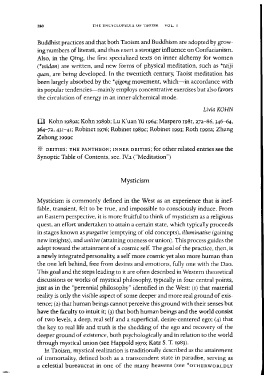Page 160 - The Encyclopedia of Taoism v1_A-L
P. 160
12.0 THE ENCYCLOPEDIA OF TAOISM VOL. I
Buddhist practices and that both Taoism and Buddhism are adopted by grow-
ing numbers of literati, and thus exert a stronger influence on Confucianism.
Also, in the Qing, the first specialized texts on inner alchemy for women
(*nudan) are written, and new forms of physical meditation, such as *taiji
quan, are being developed. In the twentieth century, Taoist meditation has
been largely absorbed by the *qigong movement, which-in accordance with
its popular tendencies-mainly employs concentrative exercises but also favors
the circulation of energy in an inner-alchemical mode.
Livia KOHN
III Kohn 1989a; Kohn 1989b; Lu K'uan Yii 1964; Maspero 1981, 272-86, 346-64,
364-72,431-41; Robinet 1976; Robinet 1989C; Robinet 1993; Roth 1991a; Zhang
Zehong 1999C
~ DEITIES: THE PANTHEON; INNER DEITIES; for other related entries see the
Synoptic Table of Contents, sec. IV2 ("Meditation")
Mysticism
Mysticism is commonly defined in the West as an experience that is inef-
fable, transient, felt to be true, and impossible to consciously induce. From
an Eastern perspective, it is more fruitful to think of mysticism as a religious
quest, an effort undertaken to attain a certain state, which typically proceeds
in stages known as purgative (emptying of old concepts), illuminative (gaining
new insights), and unitive (attaining oneness or union). This process guides the
adept toward the attainment of a cosmic self. The goal of the practice, then, is
a newly integrated personality, a self more cosmic yet also more human than
the one left behind, free from desires and emotions, fully one with the Dao.
This goal and the steps leading to it are often described in Western theoretical
discussions or works of mystical philosophy, typically in four central points,
just as in the "perennial philosophy" identified in the West: (I) that material
reality is only the visible aspect of some deeper and more real ground of exis-
tence; (2) that human beings cannot perceive this ground with their senses but
have the faculty to intuit it; (3) that both human beings and the world consist
of two levels, a deep, real self and a superficial, desire-centered ego; (4) that
the key to real life and truth is the shedding of the ego and recovery of the
deeper ground of existence, both psychologically and in relation to the world
through mystical union (see Happold 1970; Katz S. T. 1983).
In Taoism, mystical realization is traditionally described as the attainment
of immortality, defined both as a transcendent state in paradise, serving as
a celestial bureaucrat in one of the many heavens (see *OTHERWORLDLY

